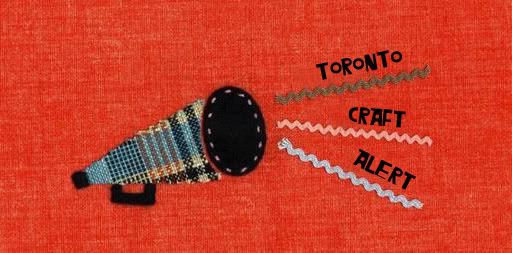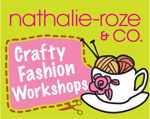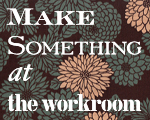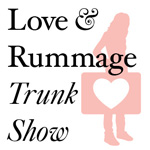CRAFTY BUSINESS WITH LAURA-JEAN: pricing
A great new Crafty Business question & answer from Laura-Jean. Email her with your own business related queries & quandaries.
Q. I'm trying to start a clothing line, but can't figure out pricing. It seems if I charge what I think the pieces are worth (labour, materials, overhead) I price my product way out of the market. Is there a standard pricing formula? How do I figure this out? Thank you, Sarah
A. Ah, Sarah, you've hit on the eternal question for so many of us craftspeople and designers! Balancing profitability with a price people will actually pay is one of the biggest challenges facing us all, and it's something you'll be working on for the entire life of your business. One standard formula is quadruple. Basically, it's double to wholesale, then double again to retail. That's right. If it costs $20 to make it should retail for $80. I've heard of people adding in 10% or so to cover those hard-to-quantify expenses: repairs on your machine, phone bill, etc. but that makes it even more challenging to keep the retail price reasonable.
Typically, starting out designers under-price. It's easy to miss out on the little expenses that add up as your business grows: thread, buttons, studio rent when it outgrows your home, printing price tags, mistakes etc. And you tend to undervalue your time. Four hours spent hand embroidering a detail on a pile of skirts counts even though you were watching 'Lost' on DVD.
On the other hand, some people overprice, counting all their expenses and time, even though their production isn't very efficient yet and their product is totally unknown and somewhat undeveloped. It takes time and experimentation to make your product worth to the public what really went into it.
Part of the process of the business is working towards a good balance. Over time, you'll find ways to streamline your production by improving your skills or process, making more of the item at once, designing it in a simpler way and generally finding ways to cut corners. You should also find less expensive suppliers, or be able to negotiate bulk prices as your business grows. You'll find you may be able to shave 10% off your production cost in 4 or 5 different areas, which really adds up.
You need to take a step back from your product, and see where it fits in the market. Ask yourself and your friends what makes your product special. If you don't have a good answer, your customer sure won't see it, and there are malls full of cute clothes that are dirt cheap! Over time, and with experimentation you'll find ways to add value to what you make without adding a lot of cost or time to the process. Often it's a tiny detail that makes someone fall in love with it, and will get them to be happy to pay the kind of price you need to get for it.
Generally I suggest people look at what they'd like to get for an item, looking at all the time and expenses, then look at what's out there that's comparable and see what price it's selling for. If those numbers are similar, you're off to a good start. Pick a price and get your stuff out there.
If your production costs are just a bit too high, I'd pick a price you can live with and get out there selling, but know that your job over the next months is to look for ways to reduce your costs and get more efficient.
If your production costs are way high, it's back to the drawing board. Let's say your specialty is handpainted artwork on teeshirts, and you think they should sell for $80, to cover all the time they take to make. Unless they are truly spectacular, it's still a tee shirt, and a very tough sell over about $50. Maybe having a simple shift dress style to serve as the canvas would increase your cost by only $20 or so, but now a handpainted dress could be $200, 300 or more! Or, if you really want to do tees, then have the art put on a silkscreen and add a few painted details that reduce your production time to minutes.
This is an ongoing challenge that I face all the time with my own line, and I see all the designers at my two collective shops, Fresh Baked Goods and Fresh Collective, working hard to find the right balance too. The market has really changed since I started my business in 1994. Since then a lot of new chains have come into
Good luck with your clothing line and thanks for the question!























3 Comments:
Pricing really is a never ending question I get asked alot as well. Now with the economic recession in full swing (no matter how much it is denied at this point in time)is having a direct effect on all our sales, and many are slashing prices. Sad, but sometimes you have to do it to keep the business in the black.
Theresa
http://www.crafterbs.blogspot.com/
Great article -- I know it's given me a lot to think about, and provided some reassurance I'm on the right track! It's just so hard to quantify some expenses -- I mean, I know how much fabric I use, but how much thread is harder for example. Thanks so much Laura Jean!
in response to pricing your craft question:
the formula i use is labour + materials x 3 = wholesale price x 2 = retail price
wholesale price is built this way:
1/3 is labour + materials (how much you decide to pay yourself for time
spent is up to you...from minimum wage/hour to...the sky is the limit), 1/3 is cost of promotion, business expenses, show costs, office supplies and so on and 1/3 is (should be) profit...this formula works for me...also, bear in mind that the final retail price has to make sense in terms of perceived value!!!
you can find this in a book called "crafting as a business" by wendy rosen who is the owner of buyers market of american craft show in philly (http://www.americancraft.com/BMAC/artist/index.html)
thanks, irina rapaport
Post a Comment
<< Home